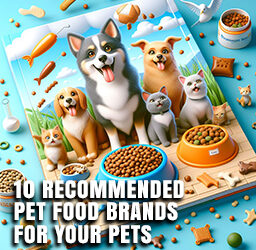Feeding Your Pet; a Complete Nutrition Guide
Are you a pet lover and worried about your furry friend’s nutrition? Well, feeding your pet can undoubtedly be a bewildering task. Every pet owner’s favorite question is: “What’s the best food for my fur baby?” Nutrition is the backbone of your pet’s health, but with the array of food options out there, you will get confused. Dogs and cats have different needs. Different dogs and cats breeds have different dietary requirements as well. Hence, guesswork would not be useful while coming up with the right feeding option for your pet.
From basic dietary requirements to modern-day choices, we have got the scoop on feeding your pet right. Dive in and let us explore pet nutrition together because your fluffy friend deserves the best food!
Feeding Your Pet Right: The Basics
Proper nutrition is paramount to a pet’s overall health and functionality. Here is a deeper look into the dietary needs of dogs:
Essential Nutrients for Dogs
- Water: It supports all vital body functions and keeps a dog happy and healthy.
- Proteins: They are crucial for muscle and tissue growth. Proper protein intake will help your dog to grow adequately.
- Fats: These are primary energy sources. Your pet will need fats in order to run, play or even go on a stroll with you.
- Carbohydrates: Carbs mainly help in activity and digestion.
- Vitamins & Minerals: Support metabolic processes and overall well-being.
These six basic nutrients play a role in nearly every body function; right from muscle contractions to cell growth. While experts have set minimum requirements for many of these nutrients, understanding their maximum tolerable amounts is equally crucial. Prolonged nutrient imbalances, whether deficiencies or surplus, can lead to health issues.
AAFCO Nutritional Guidelines for Dogs
AAFCO stands for The Association of American Feed Control Officials. It offers clear guidelines about the nutritional values of pet food brands. It is a good practice to ensure that your dog’s food aligns with AAFCO standards. However, these rules just serve as a starting point. You might have to adjust your dog’s diet depending on his health condition. Always consult your veterinarian for precise advice. They can provide insights into specific nutrients your dog might need more or less of, ensuring a well-balanced and appropriate diet.
Tips and Tricks to Get Your Pet Feed Right
Following AAFCO guidelines is important, but you should also rely on your own instincts while feeding your pet. By following a few simple tips and tricks, you can easily get the hang of how to fill your dog’s bowl. These guidelines will keep your canine friend happy, healthy and nourished for a long time!
- Natural Ingredients
If you are a new dog owner, navigating the supermarket for dog food might seem scary. However, you must adhere to just one tip. Go for food options with natural and easily recognizable ingredients. Do your own research from home and get simple ingredients instead of fancy ones.
Imported pet food should be the best choice, as most of the international brands cater to various dog breeds effectively. If most of the list sounds alien, consider a different choice or change the brand.
2. Count Those Calories
Most grown dogs, especially those indoors and neutered, do not need a lot of calories. Choose a diet with fewer than 350 calories per cup. High-calorie diets can be tricky; even a tad extra can lead to weight gain. Let us suppose that the pet food contains 500 calories per cup. If your furry friend is around 20 lbs., there is no need to give him such calorie-rich foods.
3. Make a Consistent Feeding Schedule
Thinking about how often to feed your furry friend? Let us have a look. To start off, find out the total quantity of food that your dog requires per day. Then, spread this out into 2 or 3 smaller meals. This approach is not just for their appetite – it is for their health. Feeding several smaller meals can help dodge the risk of bloating. Especially, if you have breeds like Great Danes or Irish Setters, smaller meals are a must.
Now, some people like the approach of ‘free-feeding’. That’s where you let your dog nibble whenever they want. If that is what you do, just measure out the day’s food each morning. When it is gone, do not give any refills till the next day. The important thing is to stick to a consistent schedule. Regular routines make for happy, healthy dogs.
4. Avoid Raw Food
Consuming raw food can have severe effects on your dog’s health. It contains a lot of germs and can drastically deteriorate your dog’s immune system. Now, where can a dog find raw food from? When you take him out for a walk or even a hunt, he might come across raw food. It is up to you to be watchful. Make sure he does not eat any raw meat or pet food. Always cook his food well and follow safety guidelines.
5. Feed the Right Amount
Feeding the right quantity is essential for your dog. Take special care of the portion size and consistency in feeding times. Overfeeding or underfeeding can have adverse effects on your pet’s health. It is important to keep your vet in the loop at all times. Your furry friend should not feel malnourished in any way. Alternatively, overeating is also not good, so be mindful!
6. Consider Special Dietary Requirements
Dietary needs are a crucial aspect of dog feeding. Some dogs have specific dietary needs, like allergies or weight concerns. Some dogs can have joint problems or digestive conditions. Know these and adjust their diet accordingly. You must take special care to prepare their meals under your own supervision to avoid any risks.
7. Human Foods? Think Twice!
If you are thinking about feeding human food to your animal, please do not make this mistake. Many of our treats are toxic for dogs. Chocolate, caffeine, onions, grapes, raisins, alcohol, garlic and anything with xylitol are a strict no-no. It is best to consult your vet if you are not sure.









Leave a Reply